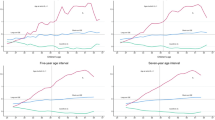Abstract
Numerous studies have estimated a high intergenerational correlation in economic status. Such studies do not typically attend to potential biases that may arise due to survey attrition. Using the Panel Study of Income Dynamics – the data source most commonly used in prior studies – we demonstrate that attrition is particularly high for low-income adult children with low-income parents and particularly low for high-income adult children with high-income parents. Because of this pattern of attrition, intergenerational upward mobility has been overstated for low-income families and downward mobility has been understated for high-income families. The bias among low-income families is greater than the bias among high-income families implying that intergenerational elasticity in family income is higher than previous estimates with the Panel Study of Income Dynamics would suggest.
Similar content being viewed by others
References
Chadwick, L., Solon, G.: Intergenerational income mobility among daughters. Am. Econ. Rev. 92, 335–344 (2002)
Charles, K., Hurst, E.: The correlation of wealth across generations. J. Polit. Econ. 111(6), 1155–1182 (2003)
Corak, M.: Generational Income Mobility in North America and Europe. Cambridge University Press, Cambridge (2004)
Corak, M., Heisz, A.: The intergenerational earnings and income mobility of canadian men. J. Hum. Resour. 34, 504–533 (1999)
Duncan, O.D., Featherman, D., Duncan, B.: Socioeconomic background and achievement. Seminar Press, New York (1972)
Fitzgerald, J., Gottschalk, P., Moffitt, R.: An analysis of the impact of sample attrition in panel data: the michigan panel study of income dynamics. J. Hum. Resour. 33(2), 251–299 (1998a)
Fitzgerald, J., Gottschalk, P., Moffitt, R.: An analysis of the impact of sample attrition on the second generation of respondents in the michigan panel study of income dynamics. J. Hum. Resour. 33(2), 300–344 (1998b)
Fitzgerald, J.: Attrition in models of intergenerational links using the PSID with extensions to health and sibling models. The B.E. J. Econ. Anal. Policy 11(3) (2011). Article 2.
Grawe, N.: Lifecycle bias in estimates of intergenerational earnings persistence. Labour Econ. 13, 551–570 (2006)
Haider, S., Solon, G.: Lifecycle variation in the association between current and lifetime earnings. Am. Econ. Rev. 96(4), 1308–1320 (2006)
Hertz, T.: Rags, Riches and Race: The Intergenerational Economic Mobility of Black and White Families in the United States. In: Bowles, S., Gintis, H., Osborne, M. (eds.) Unequal Chances: Family Background and Economic Success, pp 165–91. Russell Sage and Princeton University Press, New York (2005)
Hertz, T.: Trends in the intergenerational elasticity of family income in the United States. Ind. Relat. 46(1), 22–50 (2007)
Jäntti, M., Bratsberg, B., Røed, K., Raaum, O., Naylor, R., Österbacka, E., Björklund A., Eriksson, T.: American Exceptionalism in a New Light: a Comparison of Intergenerational Earnings Mobility in the Nordic Countries, the United Kingdom and the United States. Discussion paper no. 1938 (Institute for the Study of Labor (IZA)Bonn) (2006)
Lee, C., Solon, G.: Trends in intergenerational income mobility. Rev. Econ. Stat. 91, 766–772 (2009)
Levine, D., Mazumder, B.: The growing importance of family: Evidence from brothers earnings. Industrial Relations 46(1), 7–21 (2007)
Mayer, S., Lopoo, L.: Has the intergenerational transmission of economic status changed? J. Hum. Resour. 40(1), 169–185 (2005)
Mazumder, B.: Fortunate sons: new estimates of intergenerational mobility in the United States using social security earnings data. Rev. Econ. Stat. 87(2), 235–255 (2005)
O’Neill, D., Sweetman, O., Van de gaer, D.: The effects of measurement error and omitted variables when using transition matrices to measure intergenerational mobility. J. Econ. Inequal. 5, 159–178 (2007)
Schoeni, R., Stafford, F., McGonagle, K., Andreski, P.: Response rates in national panel surveys. Ann. Am. Acad. Polit. Soc. Sci. 645(1), 60–87 (2013)
Solon, G.: Intergenerational income mobility in the United States. Am. Econ. Rev. 82, 393–408 (1992)
Waldkirch, A., Ng, S., Cox, D.: Intergenerational linkages in consumption behavior. J. Hum. Resour. 39, 355–381 (2004)
Zimmerman, D.: Regression toward mediocrity in economic stature. Am. Econ. Rev. 82(3), 409–429 (1992)
Author information
Authors and Affiliations
Corresponding author
Electronic supplementary material
Below is the link to the electronic supplementary material.
Rights and permissions
About this article
Cite this article
Schoeni, R.F., Wiemers, E.E. The implications of selective attrition for estimates of intergenerational elasticity of family income. J Econ Inequal 13, 351–372 (2015). https://doi.org/10.1007/s10888-015-9297-z
Received:
Accepted:
Published:
Issue Date:
DOI: https://doi.org/10.1007/s10888-015-9297-z




